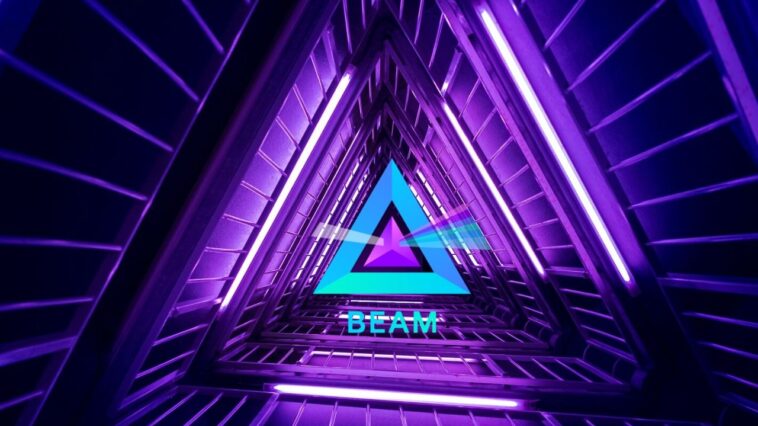Beam is an open-sourced cryptocurrency that focuses on scalability and Privacy or Confidentiality through the use of the MimbleWimble protocol.
TOKENOMICS (ACCORDING TO CMC)
Total Supply : 262,800,000 Beam
Circulating supply : 64,509,280 Beam
M. Cap : $31B
TPS : 17
Consensus Mechanism : POW
MIMBLEWIMBLE
This is named after one of the spells used in Harry Potter, the spell stops people from spilling secrets, so basically the Mimblewimble is a protocol that allows transactions to be created without having to reveal details of the transaction like the sender, the receiver or the amount transacted. Unlike the popular Bitcoin explorer where the sender’s address, receiver’s address and amount is made public, transactions with Beam cannot be seen and traced through these protocols. The Mimblewimble protocol allows Beam transactions to be completely hidden while still proving that a transaction really did take place, these hidden essential details can only be seen by the two initiators of the transaction (sender and receiver). This protocol works like a simple mathematical trick, any transaction sent is multiplied by an Unknown large number thereby leaving third parties with nothing or a fake figure on the explorer. Trying to solve the math would be something similar to this :
?? x ?? = 923
?? x ?? = 1463
Or something like this: 11 x 57 x ?? x 17 x ??= 20, 348, 031.
Those missing figures could be anything / any figures in the world, trying to figure what two figures came together to equal that would still give you the wrong answers. It’s best to simply put, you can’t discern those figures, and the most interesting part is even a computer cant. Check out more in this medium article (https://medium.com/beam-mw/mimblewimble-explained-like-youre-12-d779a5bb483d) .
AUDITABILITY
This is a feature that allows other users (auditor) to know or gain information about a particular individual transaction. This feature is chosen by the owner of the wallet, they generate a key pair for auditing, the key generated can be given to third parties that are in position to monitor the transactions conducted from that particular wallet. The auditors could also alternatively provide owners of wallets with their own public key to add to their wallet. When transactions are conducted, they come with tags which allow these auditors to see and quickly identify transactions on that address. This feature was developed so that users of Beam can give to third parties in their countries or regions if need be for regulations, example are SEC or other regulators.
HOW BEAM COMPETES WITH TOP PRIVACY COINS : MONERO AND ZCASH
CONFIDENTIALITY
MONERO utilizes Ring signatures, ring confidential transactions and Stealth addresses to obfuscate the senders of a particular transaction, amount transacted and the receiver.
ZCASH utilizes a Zero-knowledge proof known as zk-SNARKS, with this protocol Zcash is able to hide the sender, receiver and the amount transacted. Zcash private transactions are not by default. It takes about 1-3 minutes on a PC to actually conduct a private transaction on the zk-SNARKS of Zcash.
BEAM offers confidentiality or privacy by default, this means that all transactions conducted on the Beam network are private. They achieve this by utilizing the Mimblewimble protocol which makes It possible for details of a transaction to be hidden completely.
SCALABILITY
With every adoption of Monero, its blockchain continues to grow large and possibly might reduce scalability on the network. Moneros blockchain size is 63GB, it is estimated that when Monero reaches Bitcoin scale, then its blockchain size could be up to 5 terabytes which will make it hard for regular PCs to own a full blockchain.
Zcash has a blockchain size of 26GB as at the time of writing, although better than Monero but also quite up for downloads of a full blockchain.
Beams blockchain size does not grow with the number of transactions on the blockchain, instead grows with the number of Unspent Transaction Output (UTXOs). This is achieved through the cut-through mechanism of the Mimblewimble protocol, this helps Beams blockchain remain small.
AUDITABILITY
MONERO offers you a View Key option, through this feature; third parties are able to monitor incoming transactions.
ZCASH offers you a View Key option just like Monero, the feature allows other external users to track transactions on the blockchain.
BEAM allows users to create different amounts of Auditor keys and these keys can be given to any third party of their choice for auditing.
BEAM HARD FORK
Beam plans to execute a second Hard fork which will help upgrade the network, this will occur at Block 777, 777 and is expected to hit on the 28th of June, 2020.
This upgrade will shift the BeamHash II POW to BeamHash III, this upgrade will come with a lot of features on the blockchain like Activating support for confidential assets, activate support for Lelantus mimblewimble, and also support for one sided payment. The only requirements for users are to upgrade their software to the latest version. There will be a compatible release of node, wallet and miner which will be versioned as Eager Electron 5.0. Outside of that, users do not have to do any other task, the upgrade will happen automatically once it hits the Block 777, 777 and no funds will be affected during this process. Wallets are asked to be upgraded to the latest version of 5.0, and any wallet below that version will not be accessible after the Fork except updated. Miners are asked to update their wallets and mining softwares prior to the Hard Fork, after this they are to sit back and keep on hashing as described in the blog.
AFTER THE FORK
Here are lists of some of the things that will happen after the Hard Fork;
Web Wallet and Wallet Service API : This will help bring Beam to every browser and to be integrated into third parties’ wallets easily and without affecting privacy too.
Confidential Assets : This feature allows users to create and transact new kinds of token on the blockchain. All created tokens will share the same feature as Beam.
Wallet Auditability : This allows institutions or individual businesses to report their transactions easily to any third party of their choice.
Bridges to Ethereum : This will allow users to create a Beam representation of erc-20 tokens and would probably have the same market value depending on the market..
Versatility : Beams blockchain allows for different implementation of transaction types , this includes : Atomic Swaps, escrow and time-locked transactions.
You can see more here (https://medium.com/@BeamFoundation/beam-foundation-presents-roadmap-update-q1-2020-161106894cf5) .
Other Concepts of Beam
BEAM FOUNDATION : A non-profit organization with the sole aim of promoting the development and growth of Beam cryptocurrency.
Beams smallest unit is called Groth, it is named as a tribute to one of those who helped lay the groundwork for Zero-knowledge proofs.
Beam Emission : Beam is designed to be released and split between 2 bodies within the first 5 years, this is the Miner Rewards and the Treasury. During the first 5 years, miners get 80 coins per block, this will be reduced to 40 in 2-5 years and then finally in the 6th year, it will be 25 coins per block.
For the Treasury, 20 Beams are released (emitted) to it, and it will get reduced to 10 coins in 2-5 years. The Treasury is used to repay Beam investors (early investors that helped the project stand), the Core team and help support the Beam Foundation.
The treasury rewards are distributed on a monthly basis, below is a chart showing the % distributed each month and to which arm.
Exchanges
Beam is listed on a good number of Exchanges, you can grab some here
*Binance
*Bitforex
*Hotbit
*Houbi Korea
Etc
Beams Team
The Beam Foundation has a lot of solid individuals on the team ranging from Board members, Core team to advisors.
CEO Alexander Zaidelson is the Founder of Nareos, a P2P File Sharing company,he is also the founder of Wikitup which was acquired by iMesh. Alexander has served as VP Product at WeFi and served as Principal at CIRTech VC.
CTO Alex Romanov has strong technical background and managerial skills, he leads the R&D team at Beam. He has also worked on many complex projects with a large distributed team. See more Beam teams here (https://beam.mw/team#team )





